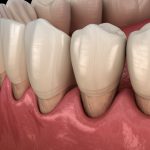Blog
Early Signs of Gum Recession: How to Spot and Prevent It Before It Gets Worse
Early Signs of Gum Recession
The early signs of gum recession are often subtle but can lead to serious oral health problems if ignored. You might first notice slight tooth sensitivity, exposed roots, or gums that seem to be pulling away. Catching these signs early is the key to protecting your smile and avoiding complex dental treatments later on.
In this article, the team at Coburg Dental Group explains what gum recession is, its most common causes, how to identify early warning signs, and what you can do to stop it before it gets worse. We’ll also explore available receding gums treatments, prevention strategies, and local insights relevant to Australian patients.
What Is Gum Recession?
Gum recession occurs when the gum tissue surrounding your teeth gradually wears away or pulls back, exposing more of the tooth or even the root. This condition can lead to sensitivity, an increased risk of decay, and eventual tooth loss if left untreated.
While mild recession is common, particularly with age, significant or rapid gum loss indicates underlying oral health problems such as gum disease (periodontitis) or poor brushing habits.
Quick summary:
- Gum recession is the exposure of tooth roots due to gum tissue loss.
- It can result from brushing too hard, gum disease, or misaligned teeth.
- Early detection is essential for prevention and preservation of your smile.
Early Signs of Gum Recession
Spotting gum recession early gives you the best chance to reverse or manage it effectively. Below are some tell-tale early signs you should never ignore.
1. Tooth Sensitivity
If you feel a sudden sharp sensation when drinking hot, cold, or sweet beverages, it may be due to exposed tooth roots. The gums act as a protective barrier when they recede, your tooth’s sensitive dentine is left unprotected.
2. Longer or “Taller” Teeth Appearance
One of the most visible signs is when your teeth start to look longer than usual. This happens as gums pull back, revealing more of each tooth’s surface.
3. Noticeable Gaps or “Black Triangles”
Gaps between teeth that weren’t there before often called black triangles can appear as the gum tissue thins out or retracts.
4. Tender or Swollen Gums
Receding gums often coincide with early gum disease. If your gums feel tender, swollen, or bleed easily when brushing or flossing, inflammation could be present.
5. Loose or Shifting Teeth
As the gums recede and bone support weakens, teeth can become mobile. This is an advanced symptom and requires prompt dental attention.
Gum Recession Causes
Understanding the root causes helps you take preventative action before gum tissue damage progresses.
| Cause | How It Contributes to Recession |
| Gum disease (periodontitis) | Chronic infection destroys gum and bone tissue. |
| Aggressive brushing | Using excessive force or hard-bristled toothbrushes damages gums. |
| Poor oral hygiene | Plaque buildup irritates gums and leads to infection. |
| Hormonal changes | Pregnancy, menopause, or puberty can make gums more sensitive. |
| Smoking or vaping | Reduces blood flow to gums, slowing healing and increasing disease risk. |
| Teeth grinding (bruxism) | Excess pressure on teeth contributes to gum tissue breakdown. |
| Crooked or misaligned teeth | Uneven bite pressure can cause localised gum wear. |
| Genetics | Some people inherit thinner gum tissue that’s more prone to recession. |
Why Early Detection Matters
Catching gum recession in its early stages can prevent irreversible damage. Once gum tissue is lost, it doesn’t naturally grow back. However, with early intervention, your dentist can halt or slow progression through professional cleaning, desensitising treatments, or gum grafting in severe cases.
Key reasons to act early:
- Prevent tooth loss
- Maintain natural aesthetics
- Avoid costly restorative procedures
- Reduce discomfort and sensitivity
If you notice any of the early signs, it’s best to book an examination with your local Coburg dentist for an accurate assessment.
How to Stop Gum Recession (and Prevent It from Getting Worse)
You can’t always reverse gum loss, but you can stop gum recession from worsening with the right care and habits.
1. Improve Your Brushing Technique
- Use a soft-bristled toothbrush or an electric toothbrush with pressure control.
- Brush gently at a 45-degree angle in circular motions.
- Avoid scrubbing horizontally across your gumline.
2. Maintain Good Oral Hygiene
- Floss daily to remove plaque where your toothbrush can’t reach.
- Use an antibacterial mouthwash to reduce bacterial load.
- Schedule professional dental cleans every six months at Coburg Dental Group.
3. Quit Smoking
Smoking reduces oxygen in your blood, impairing gum healing and increasing your risk of periodontitis.
4. Manage Teeth Grinding
If you clench or grind your teeth, your dentist may recommend a custom night guard to reduce pressure on the gums.
5. Correct Bite or Alignment Issues
Orthodontic treatment can help evenly distribute bite forces and reduce localised gum strain.
6. Treat Gum Disease Early
Early-stage gingivitis can be reversed with professional cleaning and improved home care before it advances to periodontitis.
Receding Gums Treatment Options in Australia
If gum recession is already advanced, several treatment options are available depending on the severity.
1. Deep Cleaning (Scaling and Root Planing)
This non-surgical treatment removes plaque and tartar from below the gumline and smooths the root surface to encourage gum reattachment.
2. Gum Grafting
For severe cases, gum graft surgery replaces lost tissue using either donor tissue or tissue from your own palate. This protects exposed roots and improves appearance.
3. Pinhole Surgical Technique
A minimally invasive alternative to gum grafting where the gum tissue is loosened and repositioned to cover exposed areas.
4. Desensitising or Fluoride Treatments
Applied in-clinic or prescribed as take-home products to manage tooth sensitivity caused by exposed roots.
5. Orthodontic Adjustments
Correcting misaligned teeth may relieve pressure points and prevent further gum loss.
At Coburg Dental Group, our team provides a full assessment before recommending any treatment plan. Our focus is always on preserving natural teeth and restoring gum health comfortably and effectively.
Everyday Habits to Protect Your Gums
Morning Routine Tips
- Brush after breakfast using a soft brush and fluoride toothpaste.
- Floss before bed every night to keep gums healthy overnight.
Diet and Lifestyle
- Eat a balanced diet rich in vitamin C and calcium.
- Stay hydrated saliva helps neutralise harmful acids.
- Limit sugary snacks and acidic drinks that irritate gums.
Regular Dental Visits
Routine check-ups every six months allow your dentist to detect early gum changes before they become visible to you.
Quick Answers: Common Questions About Gum Recession
Q1: Can gum recession heal on its own?
No, once gum tissue is lost, it doesn’t grow back naturally. However, early gum recession can be stabilised with proper care and professional treatment.
Q2: Is gum recession always caused by gum disease?
Not always. While gum disease is a major cause, brushing too hard, smoking, or misaligned teeth can also contribute.
Q3: How do dentists diagnose gum recession?
Through a clinical examination and periodontal charting, which measures gum pocket depth around each tooth.
Q4: Can I reverse gum recession without surgery?
In mild cases, improving oral hygiene and addressing underlying causes can prevent further loss, but regrowth usually requires grafting or specialised treatment.
Q5: Is gum recession common in Australia?
Yes. Studies show a high prevalence among adults over 30, especially smokers or those with untreated gum disease.
The Connection Between Gum Disease and Overall Health
Recent research links periodontal health to systemic conditions such as diabetes, heart disease, and rheumatoid arthritis. Receding gums may be an early indicator of chronic inflammation that affects more than just your mouth.
Maintaining healthy gums isn’t only about aesthetics it’s essential for overall wellbeing. If you notice gum changes, early dental assessment can protect both your smile and your long-term health.
When to See a Dentist
- You should book a dental appointment if you notice:
- Persistent gum tenderness or bleeding
- Teeth that appear longer
- Sensitivity to hot or cold
- Loose teeth or widening gaps
Early professional care can prevent permanent damage and save you from costly procedures later.
FAQs About Early Signs of Gum Recession
- What’s the first noticeable sign of gum recession?
The earliest and most common sign is increased tooth sensitivity, especially when consuming hot or cold food and drinks. - How quickly does gum recession progress?
It varies. Some people experience slow, gradual gum loss, while others progress rapidly due to untreated gum disease or trauma. - Is gum graft surgery painful?
Modern techniques and anaesthesia make it a relatively comfortable procedure, with most patients resuming normal activity within days. - Can electric toothbrushes cause gum recession?
Not if used correctly. In fact, many modern electric brushes include pressure sensors to prevent overbrushing. - How much does gum recession treatment cost in Australia?
Costs vary depending on treatment type and severity. A professional clean may cost a few hundred dollars, while gum grafting can range from $800 to $2,500 per tooth. Check with your Coburg Dental Group dentist for personalised advice.
Final Thoughts
Gum recession often starts quietly a bit of sensitivity here, a slightly longer tooth there — but can lead to major oral health problems if left untreated. Recognising the early signs of gum recession and taking preventive action can help preserve your gums, protect your teeth, and maintain your overall wellbeing.
At Coburg Dental Group, our experienced team provides comprehensive gum assessments, preventive care, and advanced treatments tailored to your individual needs. If you’re concerned about gum changes or sensitivity, book an appointment today and let us help you keep your smile healthy for life.





